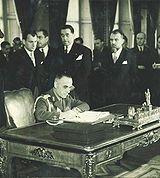- Dumitru Dămăceanu
-
Dumitru Dămăceanu (1896 – 1978) was a Romanian army officer in World War II, later promoted to Brigadier-General, who played a predominant role in the Royal coup of August 23, 1944.[1]
Before the war, he was military attaché in Rome, Italy, director at the Voievodul Mihai School, and adjutant to King Carol II.[2]
From 1941 to 1942 he was commanding officer of the 10th Roşiori Cavalry Regiment, fighting on the Eastern Front.[3] From 1942 to 1944 he was Chief of Staff of the Capital Military Command.
Colonel Dămăceanu participated in the August 23, 1944 coup d'etat led by King Michael against the government of Marshal Ion Antonescu. He organized and coordinated the military actions and resistance in Bucharest. By the end of August 1944, he travelled to Moscow with a Romanian delegation; they were received by Soviet Foreign Minister Vyacheslav Molotov on August 30 or 31.[4] On September 12, 1944, General Dămăceanu was one of the plenipotentiary signatories of the Armistice Agreement between Romania and the Soviet Union (the other signatories were Lucreţiu Pătrăşcanu, Ghiţă Popp, and Barbu Ştirbey on the Romanian side, and Rodion Malinovsky on the Soviet side).
In 1946, he was a member of the Gheorghe Tătărescu-led Romanian delegation to the Paris WW II Peace Conference. The Peace Treaty with Romania was signed in Paris on February 10, 1947, in the Salon de l'Horloge of the Ministère des Affaires Étrangères. On the Romanian side, the four signatories were Gheorghe Tătărescu Council vice President, Lucreţiu Pătrăşcanu Minister of Justice, Ştefan Voitec Minister of National Education , and Dămăceanu Under Secretary - Ministry of War. Other signatories included James F. Byrnes (US secretary of state, for the United States), Vyacheslav Molotov (foreign affairs minister, for the Soviet Union), and Ernest Bevin (foreign affairs secretary, for the United Kingdom).[5]
By then Colonel General Dumitru Dămăceanu was promoted to Army General.[1]
From August 23, 1944 to December 30, 1947 he was Under-Secretary of State at the Ministry of Interior, Council of Ministers, Ministry of War-Land Forces.
In 1932 he married Georgeta Stroescu (born October 1912, died March 1996), and he had a daughter, Gabriela Romana Dămăceanu, born in May 1938 in Rome, Italy, while he was a military attaché.
Notes
References
- (Romanian) Ion Cristoiu, "Istoria ca telenovelă - Deşănţata culme a propagandei", in Jurnalul Naţional, May 14, 2006.
- (Romanian) Andreea Sminchise, "Centenarii României – 'Pacepa mi-a distrus băiatul...'", in Jurnalul Naţional, March 27, 2007.
- (Romanian) Cornel Micu, "Armata Roşie ocupă Bucureştiul", in Jurnalul Naţional, October 26, 2005.
- (Romanian) "Tristeţea omuleţului lui Gopo", in Săptămâna Financiară, June 20, 2005
- (Romanian) "Generalul Aurel Aldea: 'Acesta este adevărul'-Document din arhivele Securităţii", from an article in Revista 22, by Claudiu Secasiu
- "Paris-WWII Peace Conference-1946: Settling Romania's Western Frontiers", notes prepared by Dan Dimăncescu from original files and records of D. Dem Dimăncescu, member of the Romanian Delegation at the Paris Peace Conference, available at the Honorary Consulate of Romania in Boston
- Rudolf Woller, "Warsaw Pact Reserve Systems: A White Paper", Bernard & Graefe, Munich, 1978. ISBN 3763752056
External links
- Short bio at Generals.dk
- "Dimitri D. Dimăncescu, 1896-1984", at the Honorary Consulate of Romania in Boston, has a photograph of Dumitru Dămăceanu at the Paris Peace Conference in 1946
- (Romanian) Cristina Diac and Florin Mihai, "1939-1944: 23 august, Cronica unui dezastru", in Jurnalul Naţional, August 23, 2006.
Categories:- 1904 births
- 1976 deaths
- Romanian delegation to the Paris Peace Conference of 1946
- Romanian diplomats
- Romanian Land Forces generals
- Romanian military personnel of World War II
Wikimedia Foundation. 2010.

